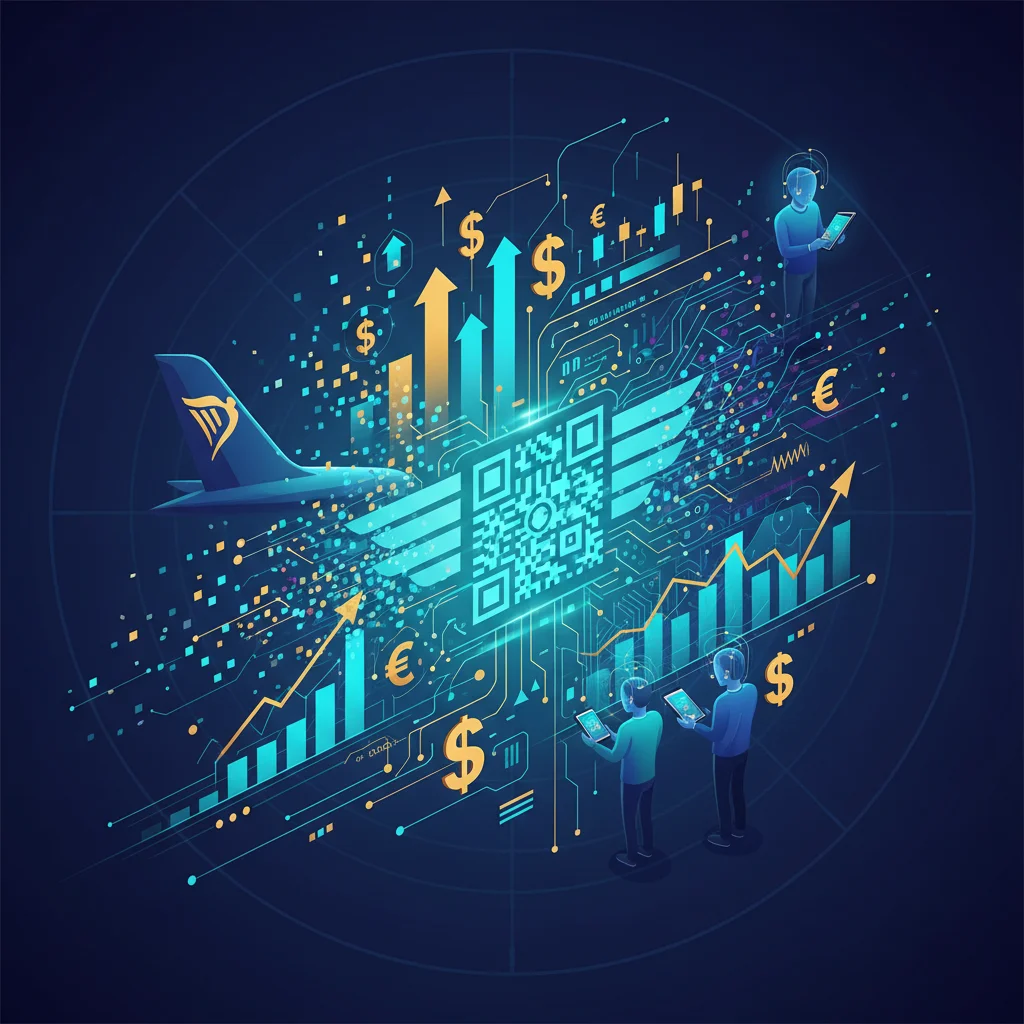
Beyond the Boarding Pass: Ryanair’s Digital Gambit and Its Ripple Effect on Finance and Investing
In what might seem like a minor operational tweak, Ryanair, the titan of low-cost European air travel, has made a decisive move: as of this week, the airline is scrapping printed boarding passes entirely, shifting to a fully digital system. On the surface, this is a story about convenience and environmental consciousness. But for astute investors, finance professionals, and business leaders, this is far more than a simple policy change. It’s a powerful signal—a microcosm of a profound digital transformation reshaping legacy industries, with significant implications for corporate finance, the stock market, and the broader economy.
This single decision to eliminate a slip of paper is a masterclass in operational efficiency and a bellwether for the future of fintech integration in consumer-facing businesses. To understand its full impact, we must look beyond the airport gate and into the core principles of modern finance, investing, and economic strategy.
The Hidden Economics of a Piece of Paper
Ryanair’s brand is built on a relentless, almost fanatical, pursuit of cost reduction. From charging for carry-on luggage to selling in-flight lottery tickets, every aspect of its operation is optimized for margin. The elimination of printed boarding passes is a classic page from this playbook, but its financial impact is more substantial than one might assume.
The costs associated with physical boarding passes are not trivial when scaled across millions of passengers. These include:
- Direct Costs: The expense of thermal paper, ink, and the specialized printers required at every check-in desk and gate across hundreds of airports.
- Maintenance & Capital Expenditure: The procurement, maintenance, and eventual replacement of this hardware represent a significant line item in an airport operations budget.
- Labor Costs: While check-in is largely automated, staff are still required to assist passengers, print passes, and manage the physical process. Reducing these interactions, even by seconds per passenger, translates into millions in saved labor costs annually. According to the International Air Transport Association (IATA), ground operations are a major cost center, and even minor efficiencies can drastically improve profitability (source).
- Airport Fees: Airlines often pay airports for the use of counter space and facilities. By driving more passengers away from desks and towards a self-service app, Ryanair can potentially negotiate better terms or reduce its physical footprint at airports.
This move is a tangible example of how digital transformation directly impacts a company’s bottom line. For investors analyzing Ryanair’s stock, this isn’t just about saving on paper; it’s about reinforcing the company’s commitment to maintaining the leanest operational model in the industry, a key factor that has historically driven its stock market performance.
The UK's Fiscal Tightrope: Will the "Tax Lock" Promise Hold in a Shifting Economy?
A Case Study in Digital-First Corporate Strategy
Ryanair’s decision is a powerful case study in the broader trend of digital transformation. It represents a shift from a multi-channel approach (offering both print and digital) to a digital-native mandate. This forces customer behavior change and allows the company to streamline its entire operational backend. The benefits extend far beyond cost savings.
A fully digital ecosystem, centered on the airline’s mobile app, creates a powerful, direct-to-consumer channel. This ecosystem enables:
- Enhanced Data Collection: Every interaction within the app provides valuable data on customer behavior, travel patterns, and purchasing habits. This data is the lifeblood of modern marketing, allowing for hyper-personalized offers for ancillary services like seat selection, priority boarding, and rental cars.
- Increased Ancillary Revenue: The app becomes the primary point of sale. It’s much easier to upsell a customer with a targeted, in-app notification than through a conversation at a busy check-in counter. This focus on ancillary revenue is a cornerstone of the low-cost model’s profitability.
- Improved Operational Flow: Digital passes can be scanned faster than paper ones, reducing queues at security and boarding gates. This improves on-time performance, a critical metric for both customer satisfaction and operational efficiency, as delays have cascading financial consequences.
To illustrate the strategic advantage, consider the contrast between legacy and digital-first operational models in the airline industry.
| Operational Area | Legacy Model (with Physical Processes) | Digital-First Model (e.g., Ryanair’s New Policy) |
|---|---|---|
| Customer Check-in | Multiple channels: web, kiosk, staffed desk. High potential for friction and need for staff intervention. | App-centric. Mandates digital check-in, freeing up staff for exceptions and complex issues only. |
| Data & Analytics | Fragmented data from various touchpoints. Difficult to build a single customer view. | Centralized data collection via the app. Enables real-time analytics and personalization. |
| Cost Structure | Higher fixed costs related to physical infrastructure (desks, printers) and associated labor. | Lower operational costs. Shifts investment from physical assets to scalable financial technology (Fintech). |
| Revenue Generation | Ancillary sales opportunities are present but less targeted and occur at multiple, less-controlled points. | Optimized, data-driven ancillary sales pushed directly to the customer’s device at key moments. |
The Fintech Engine Powering the Plane
At its core, this strategic shift is powered by financial technology, or fintech. The Ryanair app is no longer just a utility for displaying a QR code; it’s a sophisticated fintech platform. This is where the story becomes particularly relevant for those in banking, finance, and technology sectors.
The app serves as a digital wallet, a payment portal, and an identity verification tool. By mandating its use, Ryanair is embedding its financial ecosystem into the customer journey. This opens the door to a host of future fintech innovations. We are seeing a convergence where every successful consumer app, whether for travel, food delivery, or retail, is becoming a fintech company. A Forbes analysis highlights how embedded finance is revolutionizing the travel industry, turning simple transactions into integrated financial experiences.
Looking ahead, the possibilities are vast:
- Integrated Payments & Lending: Imagine “Fly Now, Pay Later” options integrated directly into the booking process, powered by a partner bank or Ryanair’s own financial arm.
- Blockchain for Identity: While still nascent, blockchain technology offers the potential for secure, self-sovereign digital identities that could one day replace passports and boarding passes entirely, creating a seamless, cryptographically secure travel experience.
- Loyalty Programs as Digital Assets: Loyalty points could be tokenized and traded or used within a broader ecosystem of partners, all managed through the central app, blurring the lines between a loyalty program and a digital currency.
By forcing its entire customer base onto a single digital platform, Ryanair is building the foundation for these future revenue streams, transforming itself from a simple airline into a travel-tech company. This is a crucial distinction for anyone conducting a financial analysis of the company’s long-term growth potential.
The £85 Billion Anchor: How Britain's Health Crisis is Sinking its Economy
What This Means for the Stock Market and Investors
For the investment community, moves like this are critical signals to parse. Wall Street and other financial centers reward companies that demonstrate a clear path to margin expansion and technological leadership. Ryanair’s decision is a tangible, easily understood action that signals several positive attributes to the stock market:
- Aggressive Cost Management: It reaffirms the company’s core investment thesis as a low-cost leader. In an industry with notoriously thin margins, every basis point counts.
- Technological Adoption: It positions Ryanair not as a legacy airline but as a forward-thinking technology company. This can lead to a re-rating of its stock, with investors willing to pay a higher price-to-earnings (P/E) multiple, similar to how tech stocks are valued compared to traditional industrials.
- Future-Proofing the Business: By building a direct, digital relationship with its customers, Ryanair is insulating itself from disruption by online travel agencies (OTAs) and other intermediaries, securing its long-term market position. A recent study on digital maturity showed a direct correlation between digital adoption and long-term enterprise value (source).
From a trading perspective, such announcements can create short-term positive sentiment. However, the real value for long-term investing lies in recognizing this as part of a larger, consistent strategy. It’s evidence that management is not complacent and is continuously seeking innovative ways to apply technology to enhance its economic moat.
The Macro-Economic Ripple Effect
Zooming out, the “Ryanair effect” has broader implications for the economy. It is a textbook example of the economic principle of creative destruction, where new, more efficient methods (digital apps) replace older, less efficient ones (paper and people).
This trend contributes to productivity growth, a key driver of long-term economic health. However, it also raises important questions about the labor market. While the move creates demand for high-skilled jobs in software development, data science, and digital marketing, it simultaneously reduces the need for traditional customer service and administrative roles at airports. This shift is a microcosm of the technological transformation happening across the entire economy, from banking to retail.
Furthermore, it highlights the increasing importance of digital infrastructure as a core component of economic activity. A society that relies on digital boarding passes also relies on ubiquitous mobile networks, reliable power grids, and robust cybersecurity—a dependency that policymakers and economists must consider in national infrastructure planning.
The £101 Million Wake-Up Call: How a Cyber Attack Halved M&S Profits and Redefined Investor Risk
Conclusion: More Than Just a Flight of Fancy
Ryanair’s decision to eliminate printed boarding passes is a deceptively simple move with profound and far-reaching implications. It is a financial strategy wrapped in an operational policy. It demonstrates a deep understanding of the levers that drive profitability and shareholder value in the 21st century.
For the general public, it’s a small change in their travel routine. But for those who study the intricate dance of finance, technology, and economics, it is a clear and powerful signal. It underscores that in today’s market, the companies that win are not just those that offer a good product, but those that relentlessly optimize every process, embrace financial technology, and have the courage to push their customers—and their industries—into the future. This is a story about more than just a boarding pass; it’s a glimpse into the future of business itself.


